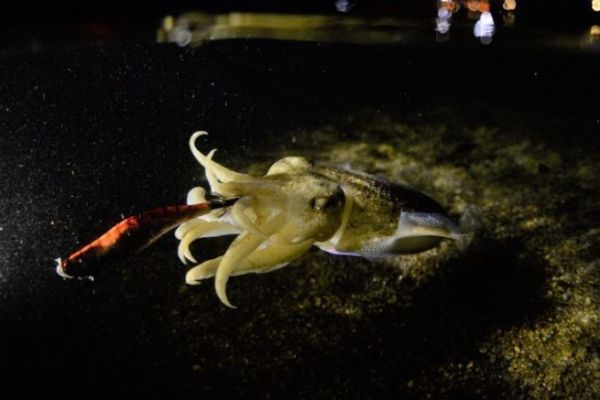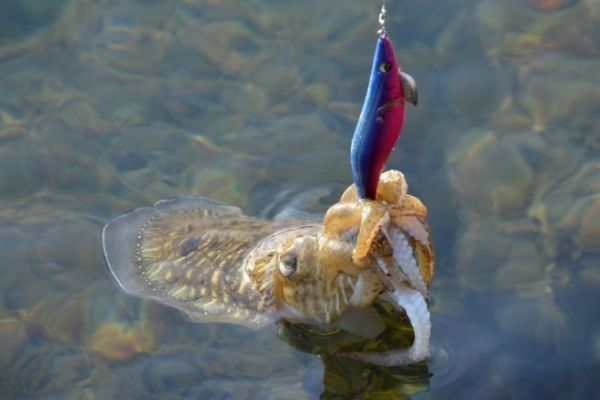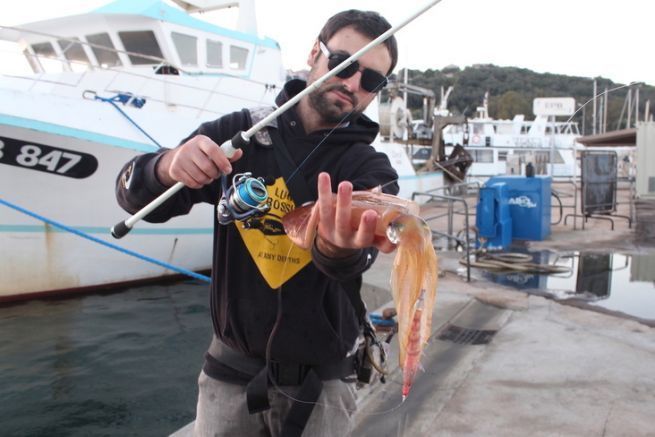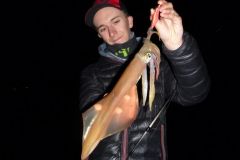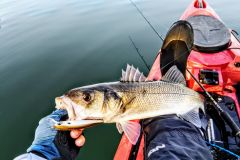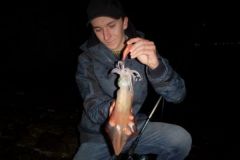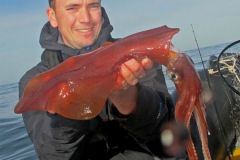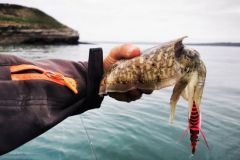Octopus
The octopus is certainly one of the most fascinating animals to fish for. It's mostly sought after for the line and the souvenir photo. Let's find out more about this cephalopod.

Two octopuses are usually found on French coasts: the common octopus ( octopus vulgaris ), the most common, and the spotted octopus ( callistoctopus macropus ) (also known as the long-armed octopus), a rarer species that is most often seen in winter. The latter can be recognized by its red color, longer, thinner tentacles and prominent phosphorescent (!) white spots. Both species can weigh from 100 grams to nearly 4 kilograms!
Unique mimetic abilities
Octopuses have a large head with eight tentacles equipped with suction cups. Two syphons allow them to breathe and move by propelling water. Their ability to mimic is virtually unrivalled in the animal world. Octopuses rapidly change color depending on the substrate, from light to dark to bright red! Their skin can also tighten or contract, creating small reliefs, so they blend in even better with rocks covered in small asperities and algae. These mimetic abilities enable them to evolve in a wide range of benthic (near-bottom) environments: sand, mud, rocks, boulders...
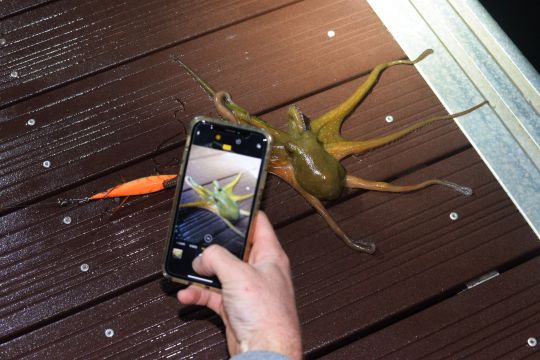
Diet
Its varied diet also allows it to live just about anywhere: shellfish, fish, crustaceans, other cephalopods... You name it. It possesses a venom that is particularly effective against shellfish. After piercing the shell, it injects this venom, which relaxes the nerves of the shellfish, which can then be eaten by the octopus. A bite is never harmless, but they are exceptionally serious. I've never been bitten by an octopus, despite regularly risky handling. When handling an octopus, beware of the beak, and never leave it too far out of the water, even if it is quite robust.
Octopus-eating fish!
The octopus's predators are the sparids, which love cephalopods and don't spare it with their powerful teeth (denti, pagre, daurade grise...). Groupers are also very fond of our eight-tentacled friends. Last but not least, moray eels are an octopus's nightmare, as they live in the same environments as octopus and compete for the holes and other cavities that make up their preferred habitats.
Found as far north as the English Channel, they are very common and fished mainly in the Mediterranean. These creatures are traditionally sought after in the Mediterranean for their firm, tasty flesh. I confess that I really can't bring myself to kill such an animal, which fascinates me in so many ways.
If, like me, you only fish for octopus for a souvenir photo and to tease the animal, beware... The octopus is a very powerful and robust animal.
Squid
Highly prized for its meat or for its fishing, squid keeps long winter evenings at the water's edge busy. They can be found on all our coasts, and fishing them is fun and accessible.
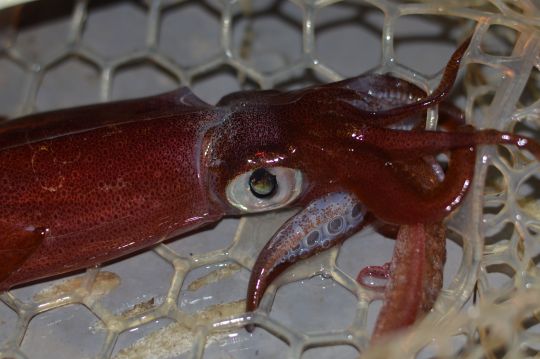
Squid is a highly prized cephalopod. Numerous species can be found in all seas and oceans. Some can reach considerable sizes, others are tiny, some are luminous, others can hover above the water! In France, it's almost exclusively the white squid ( loligo vulgaris ) that we'll come across. Visit red squid ( illex coindetti ) is rarer and found mainly on the edges of trenches or deep areas, where it is accustomed to evolving. The latter can be fished by boat at great depths (up to 1000 m!)
Gregarious cephalopods
White squid can measure (tube size) from 10 cm to nearly 60 cm for specimens. Unlike octopus and cuttlefish, they swim closer to the bottom and cover greater distances. They are true swimmers. They are gregarious, living in schools ranging from a few individuals to several hundred!
Night fishing for white squid
Loligo vulgaris is a common sight on all our coasts. It is most common in late autumn to early spring, when the waters cool. They are mostly caught at dusk or at night. They then move closer to the shore to hunt for fish or crustaceans. In addition to their 8 short tentacles, they have 2 extensible arms that they project at their prey in a flash. They move backwards and forwards very quickly, using fins, wings and a syphon to expel water.
Squids have excellent eyesight and contrast perception. They have little or no color perception.
Squid fishing can be really subtle on certain evenings, and you really have to find the right lure and animation to get the bites.
Cuttlefish
Cuttlefish, like squid, are a common sight on the French coast. Delicious on the plate and delicate to catch, it will delight all fishermen.
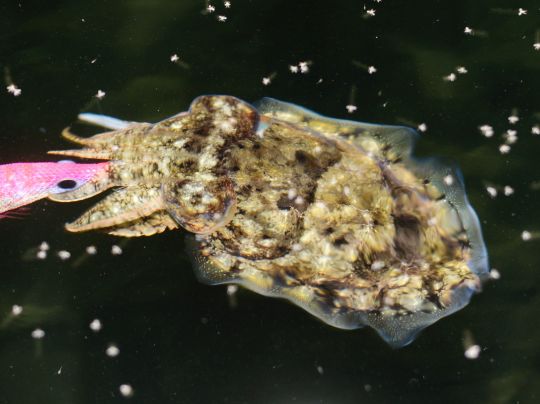
Common cuttlefish ( sepia officinalis ) has a hard bone, unlike the octopus and squid. This bone is a kind of internal shell that has evolved to adjust the animal's buoyancy. They are regularly found on our coasts and beaches, pushed along by the waves.
In the Mediterranean, cuttlefish remain rather small, rarely exceeding one kilo. In the Atlantic, on the other hand, specimens can weigh in at 2 or even 3 kilos.
A solitary cephalopod
Like octopus and squid, it is relatively fast-growing. Like the squid, its population (worldwide) tends to be stable or even increase slightly each year. Like squid, it has eight small tentacles and two extendable arms. The term "sepia", Latin for cuttlefish, also refers to the ink in the cuttlefish.
Rather solitary, cuttlefish live close to the shore and close to the bottom, where they camouflage themselves. They hunt on the lookout or move slowly in search of food. It camouflages perfectly in its environment, so if it's not moving, it's very difficult to distinguish.
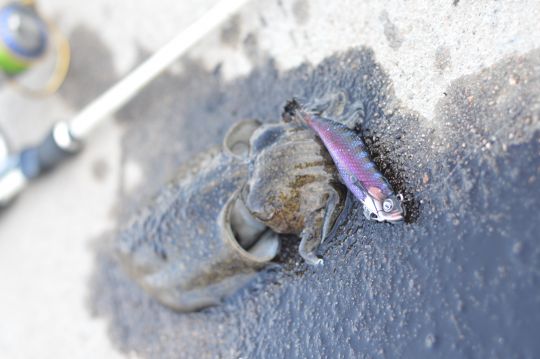
Cuttlefish, that moth!
Cuttlefish have a lot of ink, and they don't hesitate to use it. It can repaint you in a flash. It's also a real moth, and can turn around to try to bite you. Beware of the bite, which can be very painful.
Gourmets agree that this is one of the best cephalopods on the plate. We'll release the smaller specimens and try to catch the larger ones.

 /
/ 